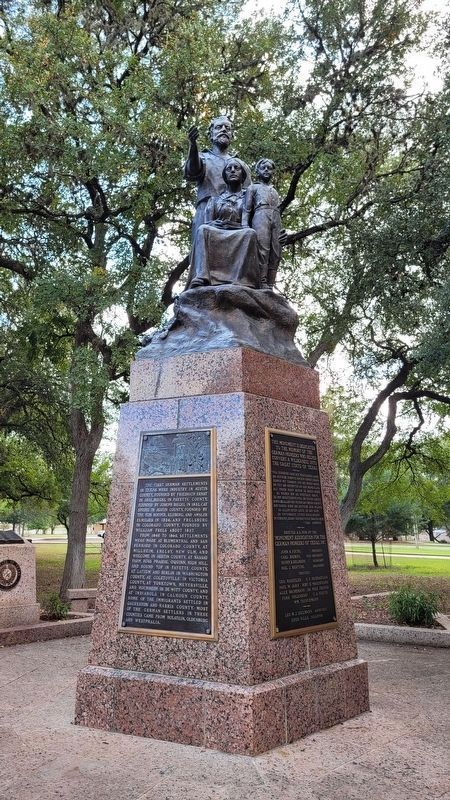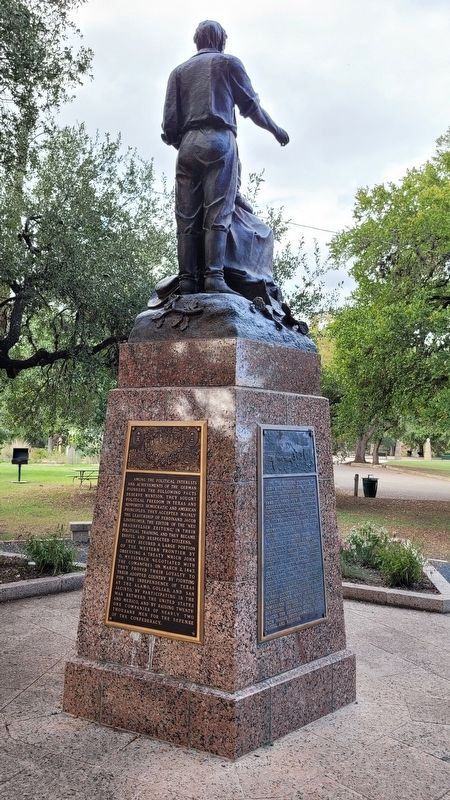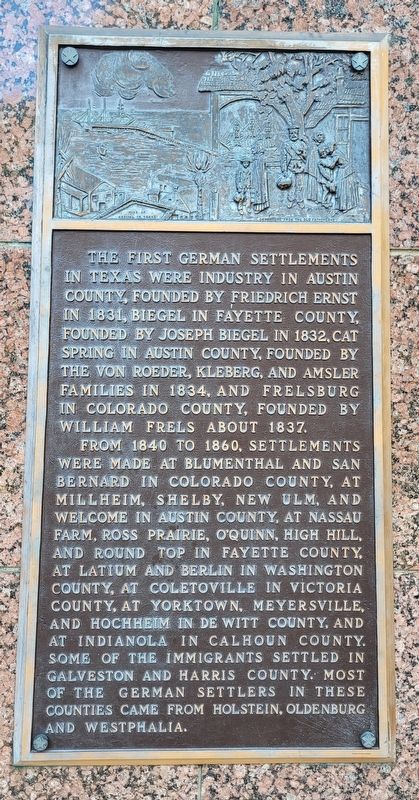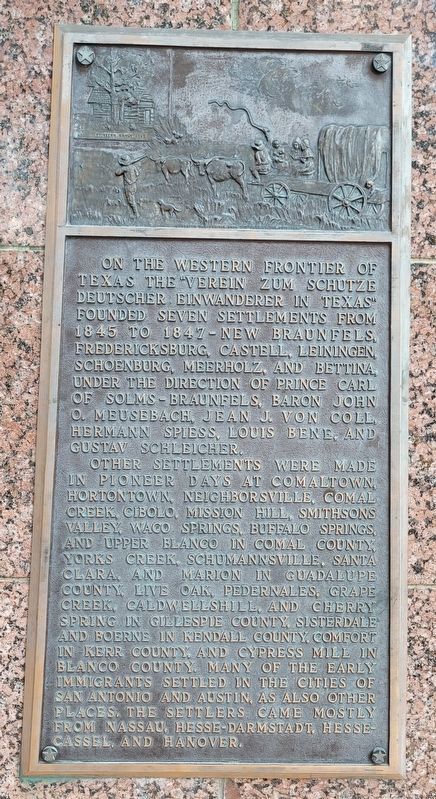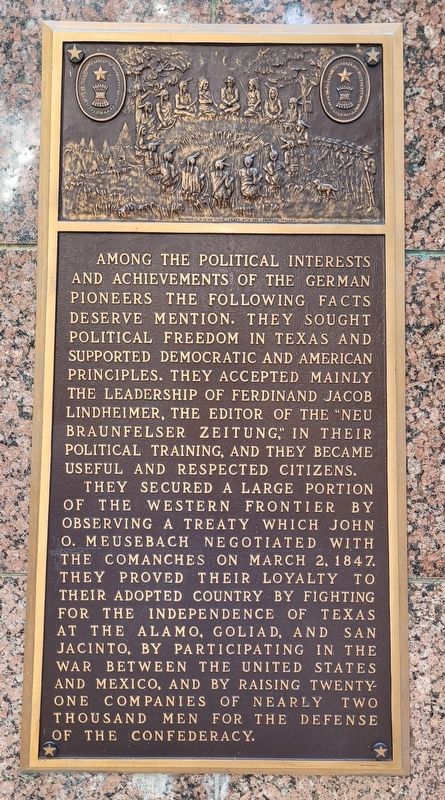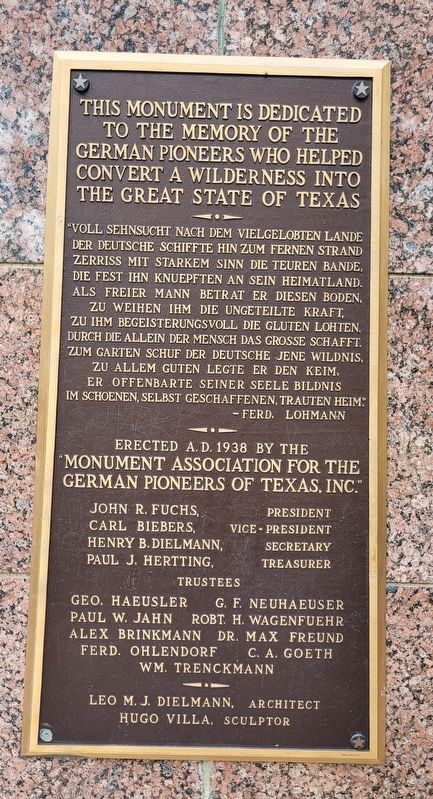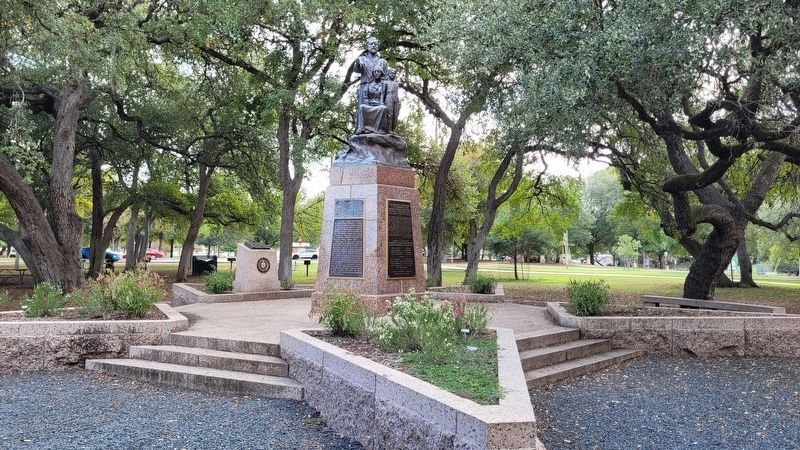New Braunfels in Comal County, Texas — The American South (West South Central)
German Pioneers Monument
Inscription.
Panel 1
The first German settlements in Texas were Industry in Austin County, founded by Friedrich Ernst in 1831, Biegel in Fayette County, founded by Joseph Biegel in 1832, Cat Spring in Austin County, founded by the von Roeder, Kleberg, and Amsler families in 1834, and Frelsburg in Colorado County, founded by William Frels about 1837.
From 1840 to 1860, settlements were made at Blumenthal and San Bernard in Colorado County, at Millheim, Shelby, New Ulm, and Welcome in Austin County, at Nassau Farm, Ross Prairie, O'Quinn, High Hill, and Round Top in Fayette County, at Latium and Berlin in Washington County, at Coletoville in Victoria County, at Yorktown, Meyersville, and Hochheim in DeWitt County, and at Indianola in Calhoun County. Some of the immigrants settled in Galveston and Harris County. Most of the German settlers in these counties came from Holstein, Oldenburg and Westphalia.
Captions
Upper Left: Port of Arrival in Texas
Upper Right: Departure From the Old Fatherland
Panel 2
On the western frontier of Texas the "Verein Zum Schutze Deutscher Einwanderer in Texas" founded seven settlements from 1845 to 1847 - New Braunfels, Fredericksburg, Castell, Leiningen, Schoenburg, Meerholz, and Bettina, under the direction of Prince Carl of Solms-Braunfels, Baron John O. Meusebach, Jean J. von Coll, Hermann Spiess, Louis Bene, and Gustav Schleicher.
Other settlements were made in pioneer days at Comaltown, Hortontown, Neighborsville, Comal Creek, Cibolo, Mission Hill, Smithsons Valley, Waco Springs, Buffalo Springs, and Upper Blanco in Comal County, Yorks Creek, Schumannsville, Santa Clara, and Marion in Guadalupe County, Live Oak, Pedernales, Grape Creek, Caldwellshill, and Cherry Spring in Gillespie County, Sisterdale and Boerne in Kendall County, Comfort in Kerr County and Cypress Mill in Blanco County. Many of the early immigrants settled in the cities of San Antonio and Austin, as also other places. The settlers came mostly from Nassau, Hesse-Darmstadt, Hesse-Cassel, and Hanover.
Captions
Upper Left: Pioneer's Early Home
Upper Middle: Crossing the Prairie from the Port to the Interior
Panel 3
Among the political interests and achievements of the German pioneers the following facts deserve mention. They sought political freedom in Texas and supported democratic and American principles. They accepted mainly the leadership of
Ferdinand Jacob Lindheimer, the editor of the "Neu Braunfelser Zeitung," in their political training, and they became useful and respected citizens.
They secured a large portion of the western frontier by observing a treaty which John O. Meusebach negotiated with the Comanches on March 2, 1847. They proved their loyalty to their adopted country by fighting for the Independence of Texas at the Alamo, Goliad, and San Jacinto, by participating in the war between the United States and Mexico, and by raising twenty-one companies of nearly two thousand men for the defense of the Confederacy.
Captions
Upper Middle: Muesebach making Peace Treaty with the Comanche Indians
Panel 4
This monument is dedicated to the memory of the German pioneers who helped convert a wilderness into the great state of Texas
German Text
"Full of longing for the much-promised land the German sailed to the far-off beach with a strong sense tore the dear ties that tied him tightly to his homeland. As a free man he set foot on this land, to consecrate him the undivided strength, to him enthusiastically the gluten blaze, through which alone man creates the great. The German created that wilderness for the garden, he planted the germ for everything good, he revealed his soul's image in the beautiful, self-created, trusted home." - Ferd. Lohman
"Monument Association for the
German Pioneers of Texas, Inc."
John R. Fuchs, President
Carl Biebers, Vice-President
Henry B. Dielmann, Secretary
Paul J. Hertting, Treasurer
Trustees
Geo. Haeusler • G.F. Neuhaeuser
Paul W. Jahn • Robt. H. Wagenfuehr
Alex Brinkmann • Dr. Max Freund
Ferd. Ohlendorf • C.A. Goeth
Wm. Trenckmann
Leo M.J. Dielmann, Architect
Hugo Villa, Sculptor
Erected 1938 by Monument Association for the German Pioneers of Texas, Inc.
Topics. This historical marker and monument is listed in these topic lists: Communications • Immigration • Native Americans • Settlements & Settlers. A significant historical year for this entry is 1831.
Location. 29° 42.709′ N, 98° 8.175′ W. Marker is in New Braunfels, Texas, in Comal County. Marker can be reached from the intersection of Landa Park Drive and Monument Drive, on the right when traveling north. The marker is located northwest section of Landa Park. Touch for map. Marker is at or near this postal address: 105 Landa Park Drive, New Braunfels TX 78130, United States of America. Touch for directions.
Other nearby markers. At least 8 other markers are within walking distance of this marker. New Braunfels Gemischter Chor Harmonie (a few steps from this marker); It All Began Here (a few steps from this marker); Mayors' Monarch Pledge (within shouting distance of this marker); Founder's Oak (within shouting distance of this marker); Landa Park (within shouting distance of this marker); The Old San Antonio Road (within shouting distance of this marker); New Braunfels (about 300 feet away, measured in a direct line); This Monument Marks the Location (about 400 feet away). Touch for a list and map of all markers in New Braunfels.
Also see . . .
1. Germans. Texas State Historical Association
The largest ethnic group in Texas derived directly from Europe was persons of German birth or descent. As early as 1850, they constituted more than 5 percent of the total Texas population, a proportion that remained constant through the remainder of the nineteenth century. Intermarriage has blurred ethnic lines, but the 1990 United States census revealed that 1,175,888 Texans claimed pure and 1,775,838 partial German ancestry, for a total of 2,951,726, or 17˝ percent of the total population. By this count, Germans rank behind Hispanics and form the third-largest national-origin group in the state. Most persons of German descent do not regard themselves as ethnic Germans, however. From their first immigration to Texas in the 1830s, the Germans tended to cluster in ethnic enclaves. A majority settled in a broad, fragmented belt across the south central part of the state. This belt stretched from Galveston and Houston on the east to Kerrville, Mason, and Hondo in the west; from the fertile, humid Coastal Plain to the semiarid Hill Country. This German Belt included most of the Teutonic settlements in the state, both rural and urban.(Submitted on November 13, 2022, by James Hulse of Medina, Texas.)
2. Meusebach-Comanche Treaty. Texas State Historical Association
The Fisher-Miller land grant comprised lands between the Llano and Colorado rivers and constituted the hunting grounds of the Comanche Indians. This land was to be used for the settlements of the immigrants who arrived in Texas under the auspices of the Society for the Protection of German Immigrants. Prince Carl of Solms-Braunfels, the first commissioner of the society, had pledged from the beginning that he would do his utmost to get on good terms with the Indians. It was, however, not until John O. Meusebach had taken charge of the affairs of the German immigrants that regular expeditions into Indian-controlled lands took place.(Submitted on November 13, 2022, by James Hulse of Medina, Texas.)
3. Lindheimer, Ferdinand Jacob (1801–1879). Texas State Historical Association
Ferdinand Jacob Lindheimer, naturalist and newspaper editor, was born on May 21, 1801, in Frankfurt am Main, Germany, the youngest son of Johann Hartmann and Jahnette Magdeline (Reisser) Lindheimer. His father was an affluent merchant. Lindheimer is often called the father of Texas botany because of his work as the first permanent-resident plant collector in Texas. He received his education at the Frankfurt Gymnasium and attended a preparatory school in Berlin. He attended the University of Wiesbaden, the University of Jena, and the University of Bonn, where he won a scholarship in philology. He returned to Frankfurt and became a teacher at the Bunsen Institute in the fall of 1827. There he became active in the political movement agitating for reform of the German government. In 1834 Lindheimer, whose political affiliations had alienated his family and placed him at risk, immigrated to the United States as a political refugee.(Submitted on November 13, 2022, by James Hulse of Medina, Texas.)
Credits. This page was last revised on November 13, 2022. It was originally submitted on November 13, 2022, by James Hulse of Medina, Texas. This page has been viewed 267 times since then and 83 times this year. Photos: 1, 2, 3, 4, 5, 6, 7. submitted on November 13, 2022, by James Hulse of Medina, Texas.
